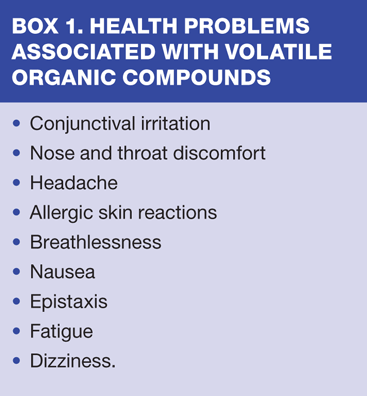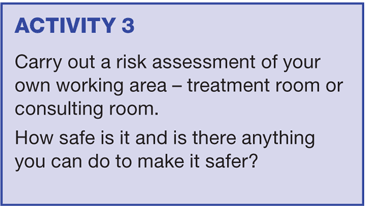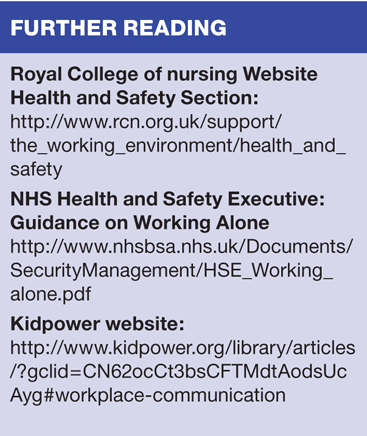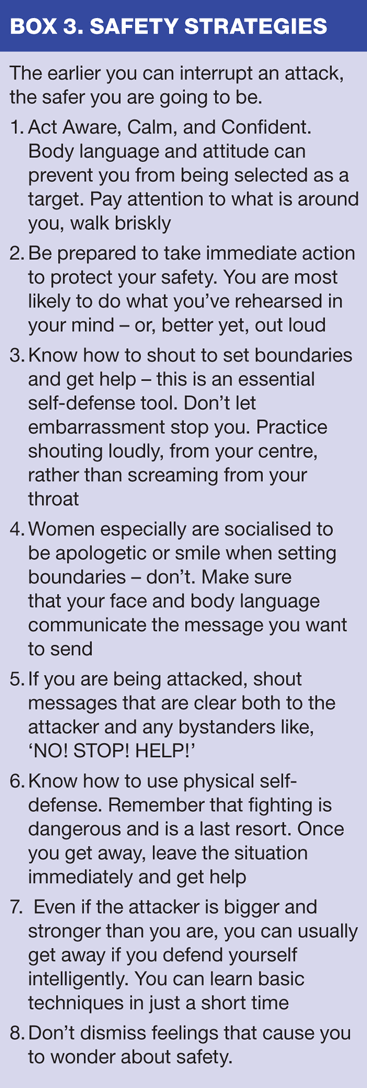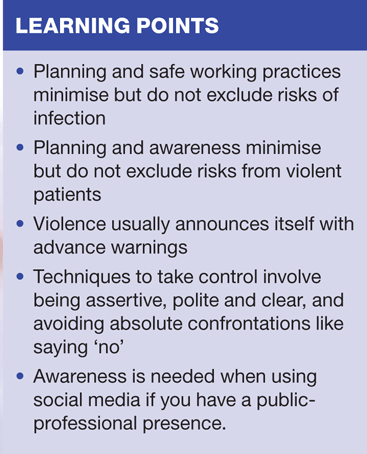Issues in personal safety
Dr Mary Lowth
Dr Mary Lowth
MA MB BChir FRCGP PCGME
GP, MRCGP examiner and medical educator
Practice nurses face a number of specific risks to their health and safety, ranging from injuries or infections acquired in the workplace to threats from patients. How can you keep yourself safe at work?
Practice nurses face significant physical and psychological demands at work, some of which are specific or unique to the job. These include workplace exposures — from injuries, exposure to toxic substances and exposure to pathogens — and direct patient risks from violent patients, stalkers and those who might take advantage of people working late and alone
This article discusses these risks and ways to minimise them. The elimination of all risk may not be achievable in the context of your particular workplace, but a risk-aware approach will serve to minimise danger.
WORK PLACE INJURIES
Musculoskeletal injury
Healthcare workers are at increased risk of musculoskeletal injuries, especially back injuries.1 This relates in part to lifting but also in part to our sedentary job.
The fact that practice nurses are not lifting and moving patients every day would suggest the risks are much lower than for, say, hospital nurses. However, it also means that on the one occasion when a patient faints or falls in the surgery we are less prepared and practised and can overstretch ourselves physically in trying to help.
The second issue is that of the sedentary job — sitting at a desk and working at a computer for long periods brings musculoskeletal problems of its own. You should make sure that your chair is comfortable, and supports your lower back. If glare from your computer screen troubles you, ask for an antiglare screen.
Your employer has a responsibility for your health and safety, and this includes safe working conditions that do not harm you.2 If you feel that your chair is causing you discomfort then your employer should take reasonable steps to find you ergonomically designed seating.
You employer should also carry out a risk assessment if there is an accident or injury relating to working conditions or equipment, or if an employee suffers a change in their health, that could affect or be affected by their work.2
Needlestick injuries
These are almost certainly underreported.1,3 Avoiding needlestick injury involves safe sharps practice at all times:
- If you've used it put it in the sharps bin
- If you notice that a bin is full take a moment, seal it up and fetch another
- If you use sharps on home visits take a sharps bin with you.
Although it may seem easier to forget about a needlestick injury and 'not make a fuss' it is vital to report and deal with such incidents, using the agreed protocols.
A 2012 Health Protection Agency (HPA)3 report stated that:
- Between 2002 and 2011, 4,381 significant occupational exposures were reported (increasing from 276 in 2002 to 541 in 2011). Most were in nurses
- Between 2008 and 2011, there were five Hepatitis C virus (HCV) transmissions from patients to healthcare workers following percutaneous exposure injuries.
The last case of an HIV seroconversion in an occupationally exposed healthcare worker was reported in 1999. This perhaps reflects the risk awareness of those working with blood and body fluids, but may also reflect the lower prevalence of HIV compared to hepatitis, the use of antiretrovirals which keep viral counts low in those who know they are affected, and the relatively high infectivity of hepatitis B in patients who are core antigen positive.4
EXPOSURE TO TOXIC SUBSTANCES
In the surgery we are exposed to a variety of chemicals in the form of aerosols, gases and skin contaminants, and latex. Many of these compounds are linked to occupational asthma, including latex, cleaners and disinfectants, pesticides, pharmaceuticals and volatile organic compounds (VOCs).
Volatile Organic Compounds
VOCs are present in a wide array of cleaning fluids, copier inks, correction fluids and permanent markers, and sprays used to disguise odours.5 Levels are generally much higher indoors and they can cause multiple health problems. (Box 1) Some may be carcinogenic.
Your exposure can be reduced by making sure that only VOC-free products are used. If VOC containing products have to be used, then ventilation should be maximised and instructions on the label adhered to.
Latex
Latex can cause serious health problems. Latex allergy affects 0.5-1.9 per 1000 fulltime healthcare workers per year.1 The condition begins with contact dermatitis, which may initially be nothing more than itching, but may become more severe. In addition to causing occupational asthma, latex may cause anaphylaxis, and lead to fixed, severe obstructive pulmonary disease. Even if your latex allergy is initially mild it may become significant over time, or if you ever need surgery yourself.
Every surgery should consider becoming a latex-free environment and every healthcare worker should reduce their occupational exposure to latex to the minimum possible.
Medications
Some medications pose risks to practice nurses,6 particularly if they are involved in delivering medication with which they are unfamiliar, e.g. antineoplastic agents via Hickmann lines.
There is plenty of advice on the safe handling of hazardous drugs. While antineoplastic drugs are the main concern, hazardous drugs include those which are:
- Carcinogenic
- Teratogenic
- Directly toxic
- Genotoxic, or
- Similar in structure to drugs known to be toxic.
These drugs may affect cell growth or cause toxic side effects at low levels. Lists of hazardous drugs can be found online,7 and include several that may be encountered in primary care including hormones, immunosuppressants, podophyllin, BCG vaccine and some antibiotics, including tetracyclines.
EXPOSURE TO PATHOGENS
In primary care people come to us when they are ill. We are therefore exposed, on a daily basis, to circulating infections, both local and pandemic, together with infected wounds and wound dressings and hospital-, holiday- and tropically-acquired organisms.
Most doctors and nurses gradually build up immunity to a wide range of community-circulating viruses. (Many of us will remember initial periods of contracting almost all the viral infections when first starting work in a clinical environment. We get it all out of the way at once!) However, new organisms and variants of old organisms are constantly arising and we cannot rely on this acquired immunity to protect us from everything.
The recent flu pandemic and concerns about avian flu mutating into more a virulent and transmissible form mean we must remain vigilant. Many were irritated by the requirement to mask and gown up when seeing our own, potentially infectious patients during the swine flu outbreak — but if we worked on an infectious diseases ward we would think nothing of this common sense approach to the unknown. We live and work in a soup of pathogens. Our health, immunisation, infection control procedures and our common sense keep us safe most, but not all of the time.
Flu viruses are not the only ones to pose a risk. If you have never had chicken pox then cases of varicella and active shingles may be a risk to you. There are other organisms that can be hazardous. For example, your rubella status matters, particularly if you are pregnant or considering trying to conceive, and you may be exposed to cytomegalovirus (CMV) or parvovirus (both potentially teratogenic) without realising it.
We may face difficult ethical questions when pandemics of infectious disease sweep through our communities. If a deadly disease comes our way health care workers are generally asked to be vaccinated. This allows us to continue to work and help those who need us. But how does this feel if vaccine supplies are limited and our families cannot be vaccinated? And how should we behave if a disease so deadly as to risk our survival reaches our shores, and there is no vaccine? It was said that when Ebola broke out doctors and nurses went home and locked their doors. Our professional duty to nurse may conflict impossibly with the wish to keep ourselves or our families healthy. Fortunately such dilemmas seldom arise. There was a time when being a nurse involved much greater personal risk on a regular basis.
We live in a relatively protected part of the world — most virulent tropical diseases have no reservoir here — and immunisation protects us against much of the worst the planet can offer. However, we should not forget that the last smallpox deaths in the UK included medical personnel who had treated the first cases.8 Care and awareness are essential.
DIRECT PATIENT RISKS
Violent patients
Patients may become violent for a multitude of reasons. They often have very high expectations of our power to help them, and we may be unable to meet these expectations. They may be angry at being kept waiting, annoyed by the attitude of staff, upset about treatment quality or anxious about health and symptoms. They may be in pain, confused or intoxicated, unsettled, anxious or depressed, grieving, stressed or psychiatrically unwell.
A third of doctors will experience some form of violence in their workplace,9,10 and nurses are likely to face similar risks. As part of the 2002 NHS Plan, the Government sought to tackle violence in GP surgeries through their Zero Tolerance campaign. During 2008-09, NHS trusts in England had one physical assault for every 61 primary care staff.9
Not all unacceptable aggressive behaviour is physical. Examples include:
- Verbal abuse, threats or gestures
- Discriminatory abuse
- Intentional damage to property
- Sexual or racial harassment
- Stalking
- nappropriate emotional attachment.
Preparation: Making your room safe
While violence from patients is unusual, we should make sure our workplace recognises it as a possibility. We work, usually alone, with patients in small rooms with single points of entry (and exit). This is not a situation you would choose if seeing a violent or threatening individual — but violence and threats are not necessarily predictable in advance, so we should be prepared.
Look around your consulting room and make a risk assessment:
- Examine the layout of the room. Seat yourself closer to the door than the patient so you can get out if you need to
- Is there anything in the room that could be used as a weapon? Move sharp items out of sight and don't place hot liquids between you and the patient
- Where is the panic alarm? These may be actual buttons or linked in with the computer system. These are not used very often so they may need to be tested.
Warning signs of possible violence
Violence can occur randomly but there are usually warning signs. The patient may start to avoid your gaze, interrupt you, swear or raise their voice or become agitated. They may start to use intimidating gestures, such as clenched fists. They may stand too close to you, pace the room or start to cause damage.
Be self-aware and, in particular, take notice of your own unease. It is telling you something. Remove yourself from the room.
Keeping control
Violence is an escalating process, so the key is to spot the early signs of possible danger and try to reverse the process.
There are a number of tried and tested strategies for dealing with angry patients (Box 2) and, you should also remember, when faced with an angry patient, 80% of communication is non-verbal. Be aware of your own body language.
If you feel that the patient may be physically violent:
- Leave the room as quickly as possible
- Avoid making sudden moves
- If your way out is blocked, activate the panic alarm or shout for help
If this isn't possible
- Talk calmly to the patient; attempt to defuse the situation.
There is a huge difference between being passive, being aggressive and being assertive. (Table 1) If you are aggressive you will escalate the patient's aggression, but being passive may prevent you from taking control of the situation. Aim to display more of the features of assertiveness in order to regain control.
High risk patients
Your practice should have a policy for dealing with patients who are considered higher risk for intimidating or violent behaviour. These are patients where you may be able to predict aggressive behavior in advance and plan for it. In some practices a different room may be used for these consultations — one in which the layout is more favourable for your safety, and where others can more easily overhear if there are problems.
It is important that the notes of such patients are flagged to alert you to the need for precautionary measures. It's too late if the patient is already in the room when you realise you are at risk.
If patients have been violent to members of the practice staff or have threatened staff safety, the incident must be reported to the police straightaway. In these circumstances, the practice can request immediate removal of the patient from the list. The PCO or CCG has responsibility for ensuring that all patients receive primary care services, if necessary within a more secure setting. These are often known as violent patient services (VPS).
Safety on home visits
Some practice nurses go out on home visits, for example to give flu vaccines. Home visits may present dangers, especially when visiting new patients. Let staff know where you are going and when you are likely to return. Take a fully charged mobile phone.
Think about where you are going and if you don't feel safe, don't go alone. Minimise your appearance as a target. Consider if it is appropriate to carry your equipment in an obvious medical bag. Do you need to go in uniform?
STALKERS AND ONLINE PRIVACY
Patients sometimes try to befriend healthcare staff, as a result of being treated by them, particularly through social media. This is generally inappropriate, as it breaches professional boundaries and may compromise care. In extreme cases it can lead to stalking.
Try to avoid being contacted outside the workplace by patients. Consider whether you want your surname or personal details listed on the practice website. Make your Facebook profile visible only to friends and friends of friends. Don't chat to patients about your personal life — it can give them the impression that you are lowering the barriers. Don't give out your personal email address or mobile number.
The Internet is a public place, so think before you post anything online.
If anything happens to make you uncomfortable, tell someone. If you think a patient may have a particular, unwanted interest in you, inform your employer and consider informing the police.
LEAVING WORK ALONE: THE EMPTY CAR PARK
This final section is applicable to anyone alone in a car park, or any other potentially vulnerable environment. Remember that attackers plan their attacks and select their victims. They prefer victims who look and behave like victims, and they prefer victims who do not take control of the situation. There are a number of strategies that you can use in circumstances where you develop a sense of unease, and these are shown in Box 3. 11
CONCLUSION
Risks to personal safety at work include risks to health, function and fitness in addition to risks from patients. Social media means that such risks may extend beyond the workplace. Awareness of self and environment, preparation and planning can serve to effectively minimise risk.
REFERENCES
1. Trinkoff AM, Geiger-Brown JM, Caruso CC et al. Personal Safety for Nurses. In Hughes RG, (ed). Patient Safety and Quality: An Evidence-Based Handbook for Nurses. Chapter 39. Rockville (MD): Agency for Healthcare Research and Quality (US); 2008
2. Health and Safety Executive. Workers' health and safety. http://www.hse.gov.uk/WORKERS/index.htm
3. Health Protection Agency. Eye of the Needle. 2012 http://www.hpa.org.uk/Publications/InfectiousDiseases/BloodBorneInfections/EyeOfTheNeedle/1212EyeoftheNeedle2012Report
4. Health Protection Agency. Prevalence of hepatitis B http://www.hpa.org.uk/MigrantHealthGuide/HealthTopics/InfectiousDiseases/HepatitisB/
5. US Environmental Protection Agency. VOCs http://www.epa.gov/iaq/voc.html
6. Polovich M. Safe handling of Hazardous Drugs. Nursing World 2004; 9(3): http://www.nursingworld.org/MainMenuCategories/ANAMarketplace/ANAPeriodicals/OJIN/TableofContents/Volume92004/No3Sept04/HazardousDrugs.html
7. Hazardous Drugs List: http://www.cdc.gov/niosh/docs/2012-150/pdfs/2012-150.pdf
8. Tovey D. The Bradford Smallpox Outbreak of 1962: A personal account: Journal of the Royal Society of Medicine: 2004; 97(5): 244—247 http://www.ncbi.nlm.nih.gov/pmc/articles/PMC1079469/
9. Croton L. Personal Safety : staying safe in consultations: GP online October 2008 http://www.gponline.com/Education/article/855415/Personal-safety---Staying-safe-consultations/
10. Medical Protection Society Website; How to handle aggressive patients: http://www.medicalprotection.org/uk/sessional-gp/issue-2/how-to-handle-aggressive-patients
11. Kidpower website: http://www.kidpower.org/library/articles/?gclid=CN62ocCt3bsCFTMdtAodsUcAyg#workplace-communication
Related articles
View all Articles

